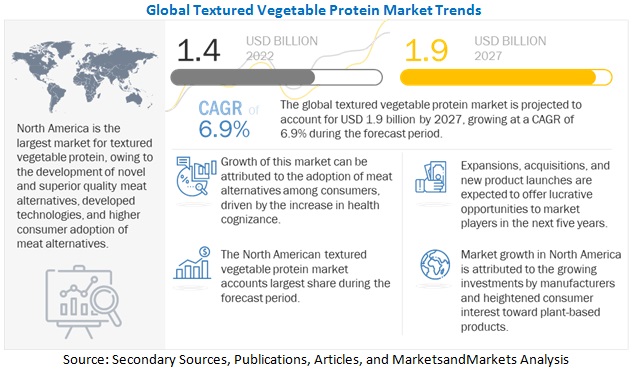The global textured vegetable protein market is estimated at USD 1.4 billion in 2022 and is projected to reach USD 1.9 billion by 2027, at a CAGR of 6.9% from 2022 to 2027. A considerable percentage of the population in western countries has shifted toward a diet with reduced meat consumption, demanding healthy and tasteful meat-free food products. Due to changes in consumption patterns among consumers, food manufacturers are emphasizing on vegetable proteins, such as pulses, wheat gluten, and soy protein, which are processed into meat-like products known as meat analogues. These products mimic certain aesthetic qualities, such as texture, flavor, color, and nutritional characteristics, of specific types of meat.

Textured Vegetable Protein Market Drivers: Innovations and developments related to vegetable protein augmenting vegan trend
According to The Food Science and Health Database Organization, in 2018, “22 million UK citizens now identify as being a ‘flexitarian,’ viewed not as a fad diet, but a permanent lifestyle choice, notably most popular among highly influential millennials.” Thus, the increasing vegan and flexitarian population is expected to drive the textured vegetable protein market during the forecast period. Increased soy and wheat crop cultivation in developing regions, such as South America and Asia Pacific, has augmented the widespread cultivation of soybean and wheat grains across the globe, resulting in the availability of soy and wheat products, such as textured vegetable proteins.
According to a study published by the European Vegetarian Union in 2019, the vegan population in Europe contributes to more than 6% of the European population. According to The Vegan Society, the vegan population in the UK increased to above 600,000 in 2019—an increase of 300% compared to 2014. This is one of the prime factors driving food and beverage manufacturers toward innovations and developments of meat alternatives, dairy alternatives, and protein nutritional beverages. This has provided a boost to plant-sourced food & beverages.
Textured Vegetable Protein Market Opportunities: Developments in extraction of textured vegetable protein from new sources
The traditional sources for the extraction of textured vegetable protein are soy, wheat, and pea. Soy has been the major source for obtaining textured vegetable protein. Manufacturers have been exploring other sources, such as lentils, fava, oats, rice, and chia seeds. Fava has been a rich source of plant-based protein and several other vitamins and minerals. They are also loaded with soluble fiber, that can aid digestion and lower cholesterol levels. Fava beans can also supply over 46% of proteins as essential macronutrients during extraction. This results in fava being a crucial alternative source for textured vegetable protein. VestKorn (US) has been offering textured vegetable protein obtained from fava.
Lentils are high-protein, edible pulses that grow in pods. They have been sold dry in countries in the Middle East and Asia Pacific. Lentils are made up of over 40% protein, which makes them an excellent meat alternative. They can be a prominent source for the production of textured vegetable protein. Chia seeds have been an excellent source of plant-based protein. One tablespoon of chia will provide 3g of complete protein, with nine essential amino acids. This fuels its usage as an important source for obtaining textured vegetable protein. Brown rice has been gaining attention among manufacturers in obtaining protein to cater to the demand for vegan and soy-free alternatives for proteins. Therefore, alternate sources pose a huge opportunity to extract textured vegetable proteins.
Healthy Snacking Habits Driving Paradigm Shift In Consumer Behavior For Textured Proteins
Cereals and snacks represent a growing portion of the textured protein market. The growing demand for plant-based foods and vegan alternatives has led manufacturers to use textured proteins in additional application areas, such as cereals and snacks. The use of textured protein granules and flakes allows for their integration into cereals and snack products and improves their mainstream adoption among consumers. The role of textured protein in cereals and snack products has grown substantially, as they were earlier utilized as a means to improve the texture of the final product. However, with the development of new sources, including wheat and pea, the use of textured proteins has witnessed substantial growth. The current line of snack products includes faux meat products, such as vegan jerky, which is manufactured using textured soy or pea, packaged crisps, and even canned foods. Textured proteins in cereals utilize flavored flakes added to products to improve their flavor and nutritional content.
Request Sample Pages: https://www.marketsandmarkets.com/requestsampleNew.asp?id=264440297
Food manufacturers in Europe have been focusing on new product developments concerning meat alternatives with better texture, appearance, flavor, and composition to attract more potential consumers.
The European market has been a strong region for textured vegetable protein. The changes in consumption patterns among consumers and manufacturers’ inclination toward developments in meat alternatives have been propelling growth in the region. According to an article shared by Green Queen Media, in 2021, the number of vegans in Europe doubled from 1.3 million to the current estimated figure of 2.6 million, representing 3.2% of the population. The growing vegan population in western European countries, such as the UK, France, and Germany, showcases robust growth prospects for manufacturers seeking to focus on product developments to grow their product portfolios.
The market for textured vegetable proteins in Europe has been driven by its use in food applications, such as meat alternatives and bakery products primarily sourced from soy and pea. The emergence of newer manufacturers of various food applications has been adopting textured vegetable proteins as a viable substitute, resulting in a growing number of product launches in the region.
Top Companies in the Textured Vegetable Protein Market
The key players in this market include ADM (US), Roquette Frères (France), Ingredion (US), DuPont (US), The Scoular Company (US), Beneo (Germany), Cargill, Incorporated (US), MGP (US), Shandong Yuxin Biotechnology Co. Ltd. (China), Axiom Foods, Inc., (US), Foodchem International Corporation (China), PURIS (US), Kansas Protein Foods (US), and DSM (Netherlands).
